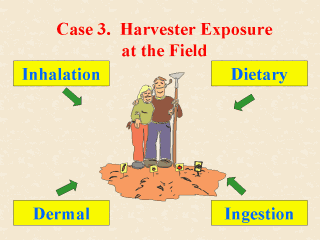| front |1 |2 |3 |4 |5 |6 |7 |8 |9 |10 |11 |12 |13 |14 |15 |16 |17 |18 |19 |20 |21 |review |
 |
Potentially,
there can be as many as 7 or 8 sources of exposure that need to be considered for
agricultural fieldworkers (e.g., apple pickers or rose cutters) reentering a treated
field. These potential sources or pathways include: (1) dermal contact with treated
foliage; (2) inhalation exposure from working in the field; (3) hand-to-mouth exposure at
the field; (4) eating fruits picked off the treated field; (5) exposure to ambient air
away from the work site; (6) dietary intake during off-work hours; and (7) drinking water. Fieldworkers often do not want to wear gloves or enough protective clothing during harvesting, unless required to do so by regulations. This is often the case during the summer when the weather is especially hot and humid. At times they also do not wash their hands or not wash them thoroughly when eating lunch or snacks, thus resulting in hand-to-mouth exposure. In practice, the dermal contact with treated foliage might be the most and perhaps the only important source or route of exposure for these workers, especially when dealing with nonvolatile, rarely-used, and short-lived pesticides. Drinking water, ambient air, and dietary intake are often included in the exposure assessment to provide the background level which should be added to yield the total body burden (i.e., the total internal dose). Depending on the chemical's physicochemical properties and the way in which it is used, at times inhalation exposure and those from the secondary sources can become important contributors to the total body burden. |